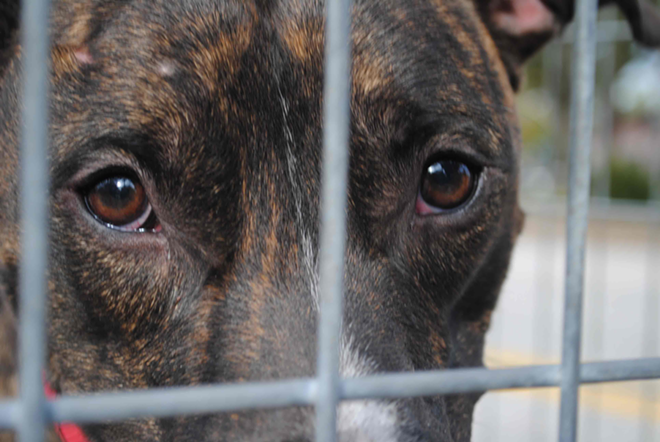I hope that dog dies.
One morning nine years ago, I woke up, made some coffee, and sat on my front porch with my 4-month-old dachshund puppy, Calypso. Across the street, a big red dog with a blocky head chased a cat. Abruptly, this dog changed direction and charged up my steps and grabbed my black-and-tan ball of fur.
Calypso, at under 10 pounds, was no match for this troglodyte. Everything you’ve heard about pit attacks – the shaking, the not letting go? — happened. I grabbed the dog’s collar and, with no small effort, pulled him off Calypso, holding him back so Calypso could get inside. When I released him to follow her, however, he pushed past me into my house, where he grabbed a terrified, screaming Calypso and shook her like a squeaky toy. I screamed and clawed at the dog, trying to get my hands in its jaws to pry them apart, finally succeeding.
I yanked him outside. Someone called in the distance, and the dog’s ears perked; I let go, and he ran. I gathered a still-shrieking, bloodied Calypso in a towel to bring her to the vet.
The dog chased us to the car.
Calypso had no broken bones, but the attack tore muscle away from her bones, so in addition to heavy doses of painkillers and copious amounts of antibiotics, the vet gave her a body bandage to help her muscle reattach to the bones.
Pinellas County Animal Services and I found the pit bull less than three blocks from my house, running loose. It had no tags, no chip, and, as far as I could tell, no owner.
I hope that dog dies. That’s what I wrote in my blog less than two hours after the attack, and 10 days later, Animal Services called to tell me no one had claimed the dog and they would destroy it. Good, I told them, and I meant it. Calypso woke screaming during the nights following the attack, screaming the same way she had after the attack.
Calypso recovered, mostly. She still screams when a big dog approaches, but she’s learned how to dominate the dogs, too.
I, however, can’t get past the panic when we see a pit.
Arin Greenwood (check out her piece on walking shelter dogs) has penned countless pieces on the affability of pits. She insists boxy-headed dogs pose no more of a threat than Calypso.
“Every reputable group that’s looked at this issue has come to the conclusion there’s no relationship between breed and a dog’s dangerousness,” she says. “We don’t have a dog census in this country, so no one knows how many pit bulls are currently lounging on people’s couches right this second. The best guess is there’s at least a few million of them, doing nothing other than being great companions. Breed and bite likelihood aren’t related.”
Evidence certainly suggests she may be right, and that Calypso’s run-in had less to do with breed and more to do with crappy owners.
Samantha Triplett, whose company, STK9, trains working and pet dogs, agrees (Read our full Q&A with Triplett at the end of this article.)
“There’s no such thing as a dog breed comprised of only ‘bad’ dogs,” she says. Both women also told CL no such breed as a “pit bull” exists.
"No one knows how many pit bulls are currently lounging on people’s couches right this second. The best guess is there’s at least a few million of them, doing nothing other than being great companions."
“It is not a set type of dog the way a Labrador retriever is,” Triplett says. “Some people consider a Staffordshire terrier a pit bull. Many in the dog world do not. These types of discrepancies cause statistics and reports to be unreliable. Reports rarely define exactly what they mean by ‘pit bull’.”
“Dogs called pit bulls are mutts,” Greenwood says, “and you don’t know a damn thing about a mutt’s personality based on how that dog looks.”
Greenwood suspects people generalize the term to talk around other issues.
“A lot of the time, people say ‘pit bull’ as a proxy for certain groups of people they don’t like but don’t feel comfortable badmouthing in public,” she says, pointing to an article discussing “gang bangers’” proclivities for pit bulls.
Perhaps. I saw more pit bulls when I lived in predominantly black Bartlett Park than I did living on lily-white St. Pete Beach, but the dog attack didn’t change my views on race: A white person’s pit scares me as much as a black person’s.
“One thing everyone can agree on is that pit bulls are terriers and, like all terriers, have a strong prey drive. This drive is what makes terriers want to hunt, catch and kill moving things,” Triplett says. “When handled properly, this drive makes a dog trainable. It’s what makes terriers such good companions and partners. They don’t possess a stronger drive than, say, the Jack Russell terrier or the Yorkshire terrier; they just happen to be bigger.”
Greenwood stresses people should neither eschew nor choose a dog based on appearance or breed.
“Using breed, or appearance, as a proxy for safety is a bad idea,” she warns. “It leads to a false sense of security with some dogs, and leads to other dogs — great dogs — facing terrible discrimination. This has real consequences, for families and dogs.”
“Most pit bulls are great dogs, but they require exercise, attention and training — just like all dogs,” Triplett says, and I suspect she’s right.
Will I ever own a pit bull?
Probably not.
Does that make Greenwood and Triplett wrong?
I hope not.
Sidebar: Rogue
Last year, St. Pete meter reader T. Collins rescued Rogue, a puppy Collins and her vet suspect local dogfighters used as bait in a local dogfighting ring. But how did “pit bulls” become the official dog of this cruel pastime?
According to Triplett, people initially trained big dogs to grab the noses of out -of-control bulls, which led to something called “bull-baiting,” or intentionally pitting dogs against angry bulls — and betting on the outcome. The name “pit bull” comes from the pits where dogs fought bulls. Once this became illegal, people would turn these bull-baiting dogs on each other. Voila, modern dogfighting.
Today, Rogue lives as a housepet with Collins. Skyway Animal Hospital treated Rogue’s severe injuries; that same office, eight years prior, treated Calypso’s not-quite-as-severe injuries. Both dogs —dachshund and pit bull — remain happy, healed, and healthy.
Because of strong emotions on both sides of the pit bull issue, CL wanted to run our unedited interview with dog trainers Samantha Triplett (Certified Master Dog Trainer, Owner of STK9 Training Company, President of Tampa Bay Protection Sports Association) and Chelsea Salzman (Pet Dog Trainer, STK9 Training Company) about the issues surrounding "pit bulls."
What evidence exists that pit bulls are not more likely to attack small animals and children than other breeds?
The media is overrun with statistics trying to rate how likely one dog is to bite you over another. The big problem with these reports is that no one can truly agree on what a “pit bull” is. The pit bull is a wide term that can be used to describe many types of terriers, bulldogs and mixes. It is not a set type of dog the way a Labrador Retriever is. For example, some people consider a Staffordshire Terrier to be a pit bull. Many in the dog world do not. These types of discrepancies cause statistics and reports to be unreliable. Reports rarely define exactly what they mean by “pit bull”. Their sample group may contain many dogs that I personally do not consider pit bulls. I frequently see news reports where a dog that is clearly not an American Pit Bull Terrier is labeled a “pit”. It makes statistics very hard to trust.
One thing that everyone can agree on is that pit bulls are terriers and, like all terriers, have a strong prey drive. This drive is what makes terriers want to hunt, catch and kill moving things. This sounds scary, but in reality that is what drives a dog to fetch a ball or chase a squirrel! Humans intentionally bred this drive into terriers for a reason. When handled properly, this drive makes a dog trainable. It is what makes terriers such good companions and partners.
Because they are terriers, they have an instinctual desire to chase small moving things. They do not possess a stronger drive than, say, the Jack Russel Terrier or the Yorkshire Terrier. They just happen to be bigger.
Due to their size and strength, however, a bite from a pit bull is more likely to send you to the emergency room than a bite from a yorkie. If it lands you in the ER, your bite is more likely to get reported.
Why are pit bulls so maligned?
The strong drives of the pit bull make it easily trainable. Being easy to train is not always a good thing, especially in the wrong hands. Humans have exploited the pit bull’s trainability and muscular body by using them as fight dogs. This has led to the misconception that pit bulls are naturally vicious, which is not the case. Fight dogs are starved, tortured and trained to fight. Pit bulls can just as easily be trained as personal protection dogs, personal assistance dogs, therapy dogs or to compete in dog sports like dock diving, agility or flyball. Fearing them due to something that they can be taught to do is unreasonable, yet many people do fear pit bulls and other breeds due to their reputation as fight dogs. In a world where very few dogs are used for the purpose that they were originally bred for, or even capable of performing the task that they were bred for, hating an entire breed for one task that few members of the breed carry out is lunacy.
What sort of argument do pit bull attacks make for breed purity – what anecdotal or scientific evidence exists to support the idea of pits of uncertain lineage attacking without provocation over ones where the bloodline is kept controlled?
Just like with any other dog, the genetics play a large role. Two mentally sound parents with good temperament are more likely to produce puppies of good temperament than two aggressive parents. Selective breeding is a well-known and widely accepted principle. Using selective breeding, humans have created the large array of breeds that exist today. If breeders chose to only breed the most mentally sound and even tempered dogs together, within a couple generations the majority of the population of pit bulls would be more sound and better tempered. The problem with this is that, again, pit bulls are not an accepted breed. There is also the fact that selective breeding can lead many breeders to employ line-breeding. It is widely accepted that when line-breeding is not employed properly it can create mentally unsound puppies. Controlling a bloodline is tricky but, if done right, could produce dogs that are much less aggressive than the norm.
Do you have any good pit bull stories?
The majority of encounters I have had, both in my personal life and as a trainer, have been overwhelmingly positive. Four years ago, I took in a foster pit bull puppy that I named Bubbles. She was a sweet, soft tempered girl that became fast friends with my other dogs and adored the humans in my life. Her only behavioral problem was being slightly timid in loud environments. When I first got Bubbles, she was around five weeks old. Once she was healthy, I began socializing her and building her confidence. I accomplished this by taking her everywhere I went, first in a puppy sling and then on a leash. Within two weeks, Bubbles was happily walking up to people and accepting treats nicely. She never had any problems with aggression. I was constantly shocked by the number of people that would immediately recoil from her (after loving and cuddling her) after learning she was a pit bull. Some went so far as to deny her entrance to their homes. This was not based on her personality, her behavior or any action made by me or her. It was based solely on the fact that she looked like a pit bull. Even after Bubbles was fully vetted and trained, it took her over a year to be adopted, despite the fact that she passed her Canine Good Citizen Test at six months old. To this day she has never displayed any kind of aggression to a dog or a human yet her family has been denied housing due to her breed. This is beyond unreasonable yet it is neither surprising nor unusual. Sadly, this is a familiar story for all pit bull owners.
Why are they called “pit” bulls?
A long time ago, people trained large dogs to latch onto the noses of out of control bulls. Humans then began experimenting and trying to develop the best dog for this task. This led to the development of bull-baiting, where people intentionally put their dogs down in a pit with an upset bull and placed bets on the outcome. Eventually this sport became illegal and humans began to fight their bull-baiting dogs against each other. This was the birth of modern dogfighting. Today’s pit bulls earned their name from the pits in which their ancestors fought bulls. This is also where bulldogs get their name.
What makes a dog attack?
Dogs attack for many reasons. To understand dogs, we have to first look at their drives (or motivations). Dogs have two main drives that can lead them to bite: prey and defense.
As mentioned previously, a dog’s prey drive is its instinct to hunt, catch and kill small moving things. When a dog chases after a biker, a squirrel or a cat, we would say it is being motivated by its prey drive. This natural instinct can get dogs in trouble. If a large dog chases after a bicycle, bites the tire and knocks over the rider, many would consider this an attack. Most likely, the dog did not mean any harm to the human rider. It was just instinctually driven to chase what appeared to be a fleeing prey item. The prey drive is why it is never wise to run from a dog. Standing still makes you much less likely to be attacked.
Defense drive is what leads to most serious bites. The defense drive causes dogs to lash out when backed into a corner or frightened. This is their natural self-preservation drive. It can also cause dogs to become territorial and possessive of their owners. Typically, dogs with strong defense drives do not attack out of the blue. These dogs give clear signals to warn other animals away. They tend to growl, bark or bare their teeth to warn intruders that they are dangerous. Dogs attack when all these warnings go unheeded and they are left with no other option. When a child chases a dog, or pulls its tail, the dog’s defense drive causes it to lash out to make the harassment stop. This does not make it a bad dog. The dog is simply doing what dogs do.
Dogs’ cortisol levels also play a factor. Cortisol, the stress hormone, accumulates in a dog’s body. This hormone remains present much longer in dogs than it does in humans. This means that a dog that experienced something stressful (such as having its tail stepped on) will remain stressed for hours. This stress will make a dog more likely to lash out than normal.
There is no such thing as a dog breed that is comprised of only “bad” dogs. That being said, it is each person’s responsibility to pick a dog that fits their family and lifestyle. You must also consider all dogs as individuals and not expect them to conform to breed standards. Most pit bulls are great dogs, but they require exercise, attention and training just like all dogs. If you are thinking of bringing a dog into your family, make sure that you have the time and energy and financial resources that you will need to keep your dog healthy and happy.




















